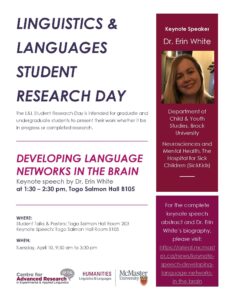By Dr. Erin White, April 10, 2018, 1:30 to 2:30 pm
Department of Linguistics and Languages will be hosting its annual Student Research Day on April 10, 2018, from 9:30 am to 3:30 pm, at TSH 203. This forum is intended for graduate and undergraduate students to present their work whether it be in progress or completed research. Dr. Erin White from the Hospital for Sick Children (SickKids) will be delivering the keynote speech on “Developing Language Networks in the Brain”, from 1:30 to 2:30 pm, at TSH B105. All are welcome!
Title: Developing Language Networks in the Brain
Keynote Speaker: Dr. Erin White
Date: Tuesday, April 10, 2018
Time: 1:30 pm to 2:30 pm
Location: Togo Salmon Hall B105, McMaster University (Please note that the location for the keynote speech is different from the rest of the Research Day)

Expandable List
Dr. Erin White uses electrophysiology (EEG) to better understand how the brain processes language, and how these processes change with development, learning and remediation. She earned her BSc from Queen’s University and her PhD from McGill University in psychology with a specialization in cognitive neuroscience and language acquisition. Dr. White completed postdoctoral fellowships at the Hospital for Sick Children (SickKids). There she led a research program to develop new protocols for mapping the brain’s functional language and reading networks in typically developing children and children who require surgery for epilepsy. In collaboration with the Hamilton-Wentworth District School Board she has also showed the success of implementing an evidence-based reading remediation program for struggling readers in local elementary schools. She has been the recipient of numerous research grants (e.g., from the Ontario Brain Institute, NSERC and FQRSC). Dr. White will join the faculty at Brock University as an assistant professor in July 2018.
During speech comprehension, how is it that we can create a meaningful representation of what was said, when different features of speech are processed by separate brain areas and at different timescales as it unfolds? During reading, how do we integrate visual, phonological and semantic information (recognition of letters, their sounds and the meaning of individual words) to build a meaningful representation of what we read? This is the so-called “Language binding problem” and it continues to be a central question in the neuroscience of language.
In this talk, Dr. Erin White will present evidence to suggest that functional connectivity (synchrony in the phase of EEG oscillations) can provide some answers. Typically developing children (ages 4-17) and adults (ages 18-36) engaged in various language and reading tasks, while EEG was recorded. The results suggest that the brain integrates language information by coordinating the rhythm of neuronal activity among distributed brain regions, allowing these regions to communicate in “functional” networks. As children develop, the frequency used for this communication, its timing, and the brain areas involved, change to permit more efficient and precise language processing. This work could provide new insights into the mechanisms of various language and learning difficulties, hopefully leading to more targeted educational and remediation programs.

